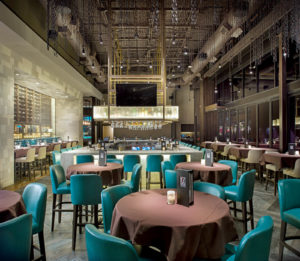
The commercial upholstery market is always evolving and changing,” says Lori Roop, director of design for CF Stinson LLC, a textile manufacturer based in Rochester Hills, Mich. Yet, Roop adds, “it’s always the same.”
A contradiction? Not really.
“There is always a huge value placed on color and design,” explains Roop, who works out of the company’s design studio in Kennebunk, Maine. “If it looks great and people are reacting to it on an aesthetic level, that’s always a win. If you can combine it with innovation, that’s a double win.”
Roop is not alone in her opinion. Both fabricators and suppliers in the commercial market—offices, health care facilities and hospitality establishments—say the role of design in upholstery has never been diminished even as performance considerations have grown in importance.
The beauty business
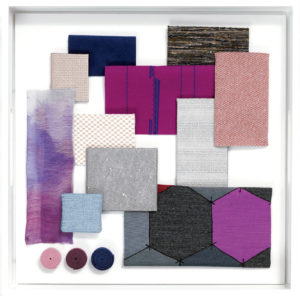
“We’re in the beauty business,” says Dorothy Cosonas, creative director for KnollTextiles, a New York City-based company that has been in business since 1947. “You have to give the market something beautiful and then support that object or idea with all the aspects that should go with it. That’s the performance and useful side that makes beauty a design.”
“While technology constantly improves for different kinds of performance such as threads and material flexibility, customers still look for ‘a wow factor,’” says Terri Madden, president and founder of Sand Sea and Air Interiors, a design and fabrication company based in San Juan, Puerto Rico. “They may want durability, but they want it with style and pizazz.”
Performance considerations—whether defined by cleanability, stain repellency, durability or some other factor—are nothing new in the commercial market. But the relative importance of those considerations, as well as how they can be achieved, can be a moving target.
There is, for example, the ongoing discussion about the chemicals used to enhance fabric performance. Some of that discussion is driven by specific legal requirements—as unclear as they may sometimes be—but also by general public sentiment based on increasing awareness of environmental issues.
“In the last couple of years, people are becoming much more aware of the environment, and thankfully so,” says Cosonas. “Then the issue is how you maintain the needed performance requirements while considering and reducing the environmental impact.
“We work very closely with our mills and they are very aware of the evolving requirements and needs and how to manufacture textiles to make sure things are not going to be problematic, now or in the future,” she says.
Meeting codes
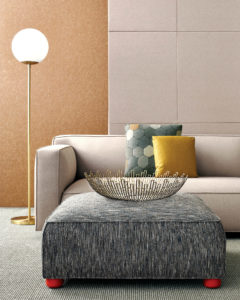
wall covering, as well as wrapped panels, a sofa and small pillow
covered in Infinite, a multi-purpose fabric. The large pillow is covered in Twist Tie and the ottoman in Code.
Photo: KnollTextiles.
“If you’re going to be putting a really beautiful fabric in a specific setting, you need to make sure it meets the applicable codes but still has the characteristics, like durability, that you want,” explains Jake Coburn, marketing and sales specialist at LebaTex® Inc., a commercial fabric supplier in Nanuet, N.Y. “The designer looks at the design aspect, but from the standpoint of a textile supplier, we look at how we’re going to provide something that is lasting.”
“At Stinson, for some of our projects, we’re focusing on achieving maximum durability along with cleanability with reduced chemistry,” adds Roop. “That can sometimes be a difficult combination to achieve, but it’s what a portion of the market wants, especially in the health care environment.”
Those changes in health care are being advanced in part by the Healthier Hospitals Initiative, an organization that promotes better practices in health care leadership, nutrition and sustainability. Hospital systems join the initiative with the goal of improving their spaces. In working with those customers who are interested in exceeding current mandated standards, the performance textile industry is reevaluating the components that, for example, make a product water-repellent.
“That’s been a big challenge for manufacturers in the last year,” says Allen Hawks, market manager for Sunbrella® Contract, the commercial upholstery arm of the Sunbrella brand, manufactured by Glen Raven Custom Fabrics in Glen Raven, N.C. “There’s a greater scrutiny of the ingredients in products we use every day. Sunbrella works with third-party organizations to ensure safety and sustainability and strives to exceed industry benchmarks.”
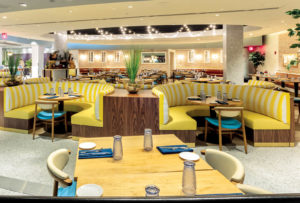
The field offers a variety of third-party certifications to regulate the safety of products. Sunbrella Contract is certified by GREENGUARD Institute’s Children and Schools standard for contributing to healthy indoor air quality by being a low-emitting interior product.
“Sunbrella Contract fabrics are certified by the NSF/ANSI 336 Sustainability Assessment for Commercial Furnishings Fabrics, which evaluates fiber sourcing, safety of materials and sustainability practices,” says Hawks. “Sunbrella Contract has also achieved a Silver Level under the NSF/ANSI 336-2011 assessment, making it the first company to offer such a broad range of compliant fabrics.”
Staying well-informed
Such challenges, whether in health care or elsewhere in the commercial market, mean that suppliers and fabricators need to stay well-informed, says Dee Duncan, president and CEO of Keyston Bros., a textile supplier in Roswell, Ga., that celebrated its 150th anniversary in 2018.
“You need to be cognizant of what’s going on in the market, because things keep changing,” says Duncan. “You need to look at what specs are being driven, and more importantly in what areas, so you know what customers need in their locale.” That’s especially imperative for companies such as Keyston, he says, because it serves customers across the country from 17 warehouse and branch locations.
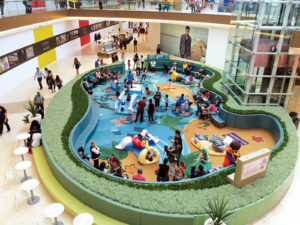
It also means that with a customer base that diverse, Keyston needs to be sure to carry products that meet a wide range of needs, says Duncan: “With stain treatment, for example, you need to tailor it for the application, whether hotels, senior living facilities, restaurants or something else. We partner with different companies that produce a variety of stain treatments to fit our customers’ needs.
“Our first question is always, ‘What is the application?’” he says. “We pride ourselves in delivering innovative textiles that will hold up to the desired application, every single time.”
Adapting to trends
Changes in commercial upholstery are also related to changes in the commercial organizations themselves. For example, according to Cosonas, the level of design in assisted living facilities is increasing as the Baby Boomer generation continues to age. “Our design awareness is different from our parents, and that’s going to be a demand and a growth area,” she says.

Another trend, she adds, involves the role of fabrics in controlling sound and acoustics in the workplace—an increasing issue as the office of the future trends toward the elimination of private offices and cubicles in favor of open spaces and social areas where employees gather to work.
“In these open layouts,” says Cosonas, “people encounter office noise and they put on headphones so they can hear themselves think or just so they don’t hear their neighbors, in many ways defeating the purpose of a collaborative space.”
According to Cosonas, KnollTextiles currently produces acoustically neutral fabric that can cover a substrate or panel—it gets wrapped on a surface so that sound can be absorbed—but is starting to develop fabrics that have inherent acoustic capabilities.
“Built into this new textile is a polyester core between the fabric face and the knit backing that helps control and absorb sound,” Cosonas says. “That’s a first for us. Five years ago, we would not have been able to develop this type of product.”
That might fit into the category of projects that Stinson’s Roop says “are mostly about innovation and technology, where you consider the design part after the technology is worked through.
“But,” Roop adds, “there always has to be that visual connection. If you miss that, you miss the whole thing, regardless of exciting technology that might be built in there.”

Jeff Moravec is a freelance writer from Minneapolis, Minn.
Sand Sea and Air Interiors, a design and fabrication company based in San Juan, Puerto Rico, has been in business since 1997. It initially focused on marine projects, but since 2010 has been doing substantial work in the hospitality and commercial markets.
Working in those markets requires considering factors for an upholstery project beyond design and fabric choice, according to Terri Madden, the company’s founder and president.
“Commercial projects often have very tight deadlines,” says Madden. “They’re also very budget-conscious. Marine customers are usually repeat purchasers, as they are often upgrading their boats, so they’re familiar with industry pricing, whereas commercial and hospitality managers are often stepping up into purchasing decisions with team approval. They may be accepting bids more by price than by quality.”
Madden believes part of her company’s job is to help educate those commercial customers about the concept of value—what’s least expensive up-front may not be least expensive in the long-term.
“We don’t do just quotes; we do proposals that we review with the customer,” says Madden. “Those proposals are based on doing a lot of research and development for fact-finding, and determining what the customer is looking for and educating them on the choices available. We have to listen, focus and ensure we get the full story.”
“It is essential to know that we are working with a customer’s key decisionmakers, which can be more easily said than done,” says Madden. “Our customer has to communicate their requirements in order to understand the parameters to build our proposals. It’s the only way to be clear about such considerations as deadlines, budget and value.
“You need to know the parameters,” she adds. “A customer might want something in a month, but your schedule is full. If you don’t find out this important information up-front, what and when they need a product, it can be an issue.”
Textile companies often respond to the needs of the marketplace. But according to Lori Roop, director of design for CF Stinson LLC, a textile manufacturer based in Rochester Hills, Mich., the company’s recently introduced Celliant® fabric collection is an example of showing the market what kind of innovations are possible.
Celliant is a patented responsive textile technology from Hologenix LLC that is embedded into the core of the fibers used in the four patterns in Stinson’s collection. Celliant can be used in a variety of fabrics (including for clothing) for a number of purposes, but the goal in upholstery is to improve energy and reduce fatigue for people who sit for long periods.
Here’s how it works, according to Roop: A combination of thermo-reactive minerals in the fabric harnesses and recycles the body’s natural energy and heat and converts it into infrared light, which is then absorbed into the body, re-oxygenating the blood and tissue cells. The improved thermal regulation and vasodilation that results is what boosts energy and lessens fatigue.
“Instead of being a reactive technology, like something meant to combat health hazards, Celliant is proactive,” says Roop. “It’s actually a health-enhancing product.”
Stinson worked for six years with Hologenix and Casey Design LLC to develop its collection.
While the Celliant products may find a home in a variety of commercial markets, Roop says it is particularly appropriate for upholstery in corporate settings, where people are sitting for much of the day—and the health hazards of doing so have become increasingly concerning.
 TEXTILES.ORG
TEXTILES.ORG


